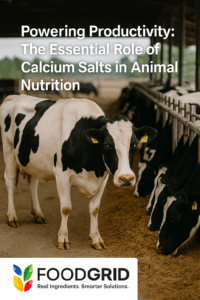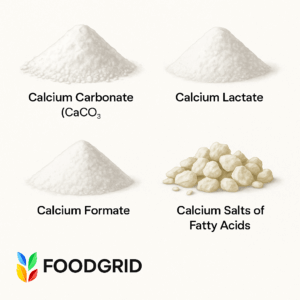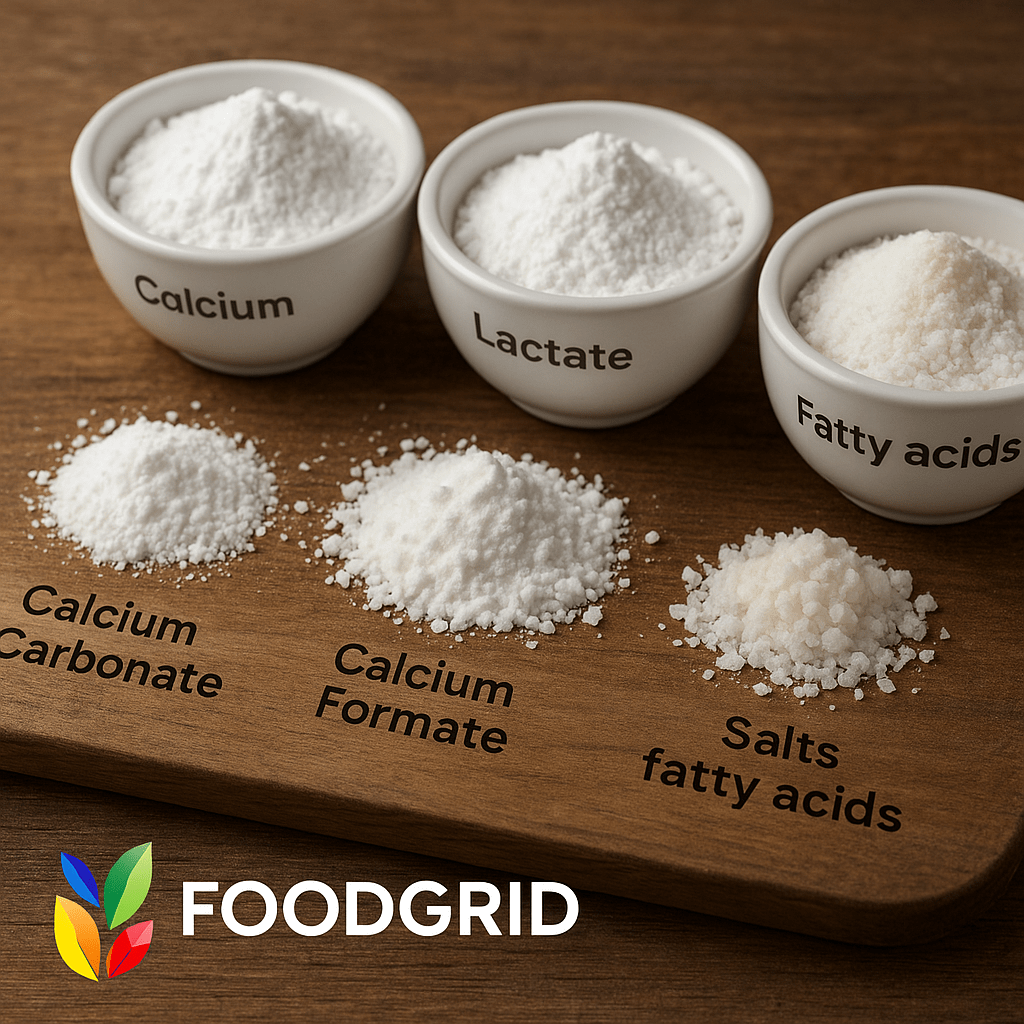For dairy producers, profitability depends on balancing nutrition to sustain productivity, fertility, and long-term herd health. Among feed additives, calcium salts are indispensable. They are not just minerals for bone health—they are critical to metabolic function, reproductive efficiency, rumen stability, and energy supply.
As the global feed additives market continues to grow at a projected CAGR of 5–6% through 2033, dairy nutrition partners are increasingly focused on solutions that improve milk yield, butterfat content, and sustainability. Calcium salts—particularly calcium carbonate, calcium lactate, and calcium salts of fatty acids (bypass fats)—remain at the center of innovation in dairy nutrition.
What Are Calcium Salts in Dairy Nutrition?
Calcium salts are compounds formed when calcium ions bind with organic or inorganic acids. In dairy feeds, they serve two major roles:
Mineral supplements that provide structural support (bones, teeth, milk production).
Functional additives that stabilize rumen health and deliver concentrated energy.
Common Calcium Sources in Dairy Diets
Calcium Carbonate (CaCO₃)
The most widely used form due to cost-effectiveness and availability.
Supports skeletal strength and prevents milk fever.
Acts as a rumen buffer to stabilize pH.
Available in granulated or micronized formats for flexible use in TMR systems.
Calcium Lactate
A highly soluble organic form of calcium.
Provides rapid absorption, useful in younger heifers or cows under stress.
Can complement carbonate in specialized diets.
Calcium Salts of Fatty Acids (Bypass Fats)
Known as rumen-protected fats.
Supply concentrated energy while delivering calcium without disturbing rumen fermentation.
Shown to increase milk yield (+2–4 kg/day) and butterfat (+0.5–0.8%).
Especially beneficial during transition and early lactation phases.
Why Calcium Is a Cornerstone in Dairy Nutrition
1. Skeletal Integrity
Calcium is the most abundant mineral in the skeleton. Consistent supplementation reduces bone demineralization, preventing fractures and supporting cow longevity.
2. Metabolic Health
Calcium plays a central role in enzymatic function, muscle contraction, and nerve transmission. It is essential to prevent hypocalcemia (milk fever)—a leading health risk in transition cows.
3. Milk Production & Butterfat Content
Calcium salts of fatty acids increase the energy density of rations without disturbing rumen fermentation. This drives higher milk volumes and improved milk fat content.
4. Fertility and Reproduction
Adequate calcium supports uterine recovery postpartum and improves reproductive efficiency.

Feeding Strategies for Dairy Nutrition Partners
Balancing Calcium and Phosphorus
Optimal Ca:P ratio for dairy cows ranges from 1.5:1 to 2:1.
Oversupply of calcium can interfere with phosphorus and zinc absorption.
Nutritionists must balance these minerals based on digestibility, not just total levels.
Targeted Supplementation by Production Stage
Transition Cows (Pre-Fresh & Post-Fresh):
Use calcium carbonate pre-fresh in low-DCAD diets to reduce milk fever risk.
Introduce calcium salts of fatty acids post-fresh to supply energy + calcium.
Lactating Cows:
Include 2–3% of dietary DM as calcium salts of fatty acids.
Supports peak milk yield and improved butterfat.
Dry Cows:
Controlled calcium supplementation prevents metabolic disorders.
Focus on carbonate-based supplementation with anionic salts in DCAD balancing.
Practical Considerations for Dairy Farm Owners & Managers
Particle Size and Handling
Fine powders increase solubility but create dust.
Granulated and coated calcium products improve flowability and reduce handling risks.
Quality and Consistency
Variability in limestone sources can affect bioavailability.
Partnering with GMP+ certified suppliers ensures consistent particle size and quality.
Regulatory Compliance
EU-approved calcium sources (E170) are essential for herds producing milk for export.
Compliance ensures smooth trade and protects market access.
Industry Trends Impacting Calcium in Dairy
Sustainability: High bioavailability reduces nutrient waste and lowers environmental impact.
Antibiotic-Free Production: Nutrition strategies rely on mineral balance and energy optimization instead of antibiotics.
Precision Nutrition: Ruminant feed specialists increasingly use digital models to fine-tune Ca:P ratios.
Global Growth in Dairy: Expanding demand for milk and dairy protein is driving innovation in mineral supplementation.

Common Challenges and Solutions
Challenge 1: Hypocalcemia in Transition Cows
Cause: Sudden calcium demand at calving.
Solution: Balanced pre-fresh diets with calcium carbonate; post-fresh supplementation with calcium salts of fatty acids.
Challenge 2: Mineral Interactions
Cause: Excess calcium interferes with phosphorus utilization.
Solution: Monitor Ca:P ratios and apply digestibility coefficients.
Challenge 3: Dust and Flowability
Cause: Micronized powders cause handling problems.
Solution: Opt for granulated calcium salts for improved mixing.
Challenge 4: Cost Pressures
Cause: Volatile feed prices.
Solution: Focus on ROI—calcium salts of fatty acids deliver measurable gains in milk and butterfat.
Economic ROI for Dairy Producers
Milk Yield: +2–4 kg/day per cow.
Butterfat: +0.5–0.8% increase = higher milk premiums.
Health Costs: Reduced incidence of milk fever and metabolic stress cuts veterinary bills.
Annual Returns: A 500-cow herd can generate $50,000–$70,000 additional income through optimized calcium supplementation.
Supplier and Sourcing Insights
Preferred Suppliers: Global providers such as Megalac and Valudor.
Purchase Formats: Bulk 1-ton pallets for efficient feeding systems.
Criteria for Selection: GMP+ certification, consistent particle size, proven field performance, and compliance with E170 regulations.
Internal Resources for Further Exploration
For more insights on optimizing feed strategies, explore FoodGrid’s resources:
References
- University of Wisconsin–Madison Dairy Science
- Journal of Dairy Science – Calcium Salts Research
- USDA Economic Research Service
- FAO – Animal Production
Calcium salts are indispensable to modern dairy cow nutrition, serving as far more than just mineral supplements. These essential compounds—whether used as calcium carbonate for baseline supply and rumen buffering, or high-energy forms like calcium salts of fatty acids—drive critical performance outcomes. Their impact spans across the entire herd lifecycle, from preventing milk fever and stabilizing metabolism in transition cows to improving milk yield and butterfat content in peak-lactation cows. Ultimately, precision use of calcium salts is fundamental to maximizing cow health, resilience, and farm profitability.
👉 At FoodGrid, we provide scientifically backed feed additives that enhance performance and profitability while aligning with animal welfare goals. Explore our solutions here: https://foodgridinc.com/ or connect with our team today to discover how calcium salts can transform your feed strategies.
